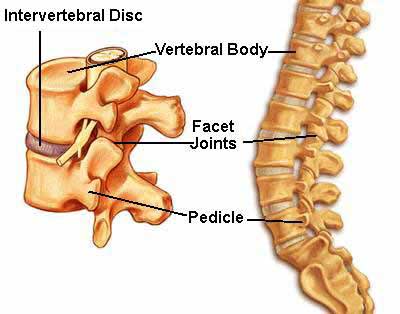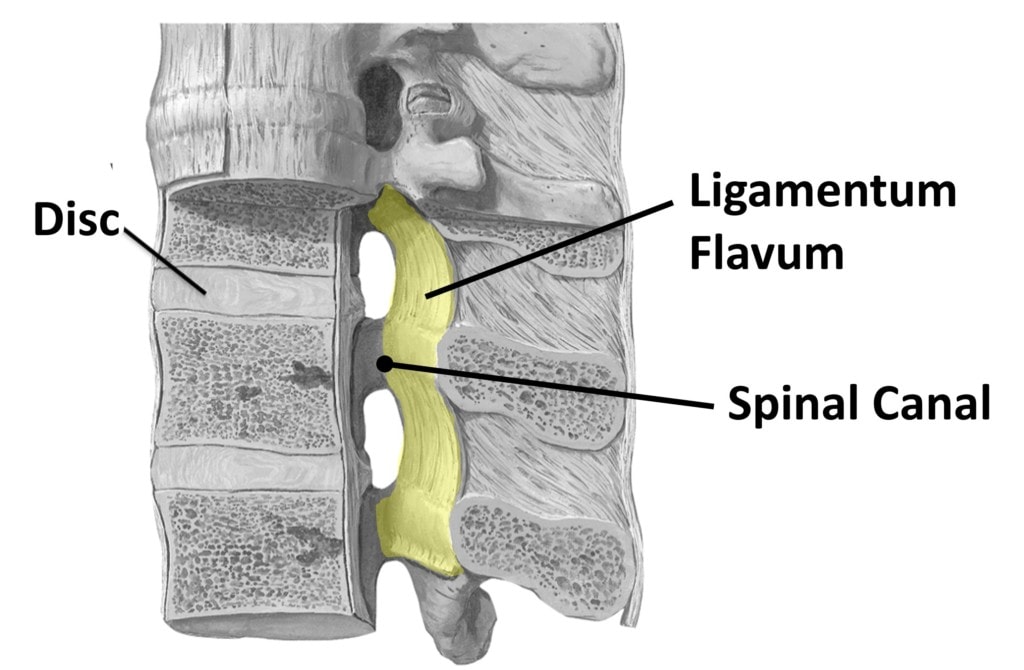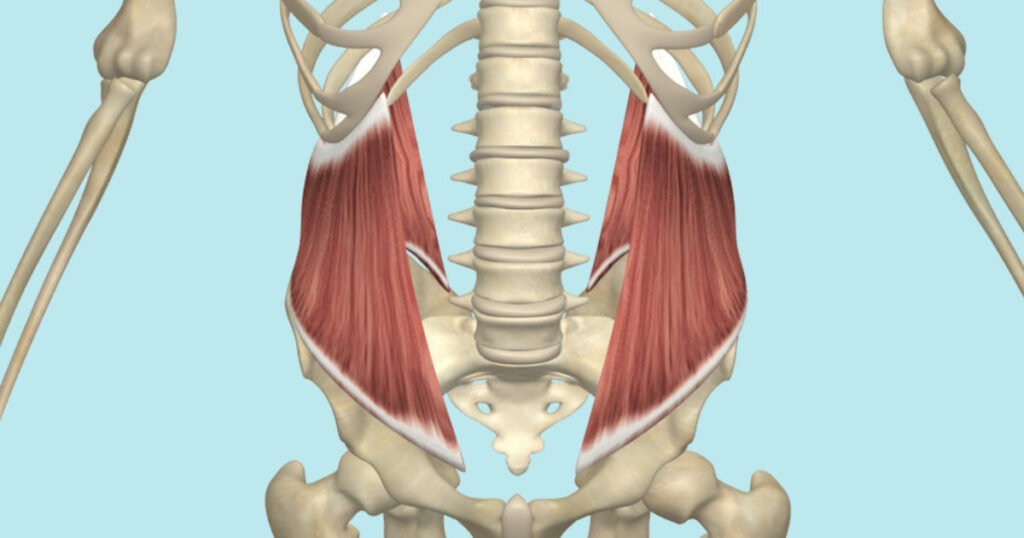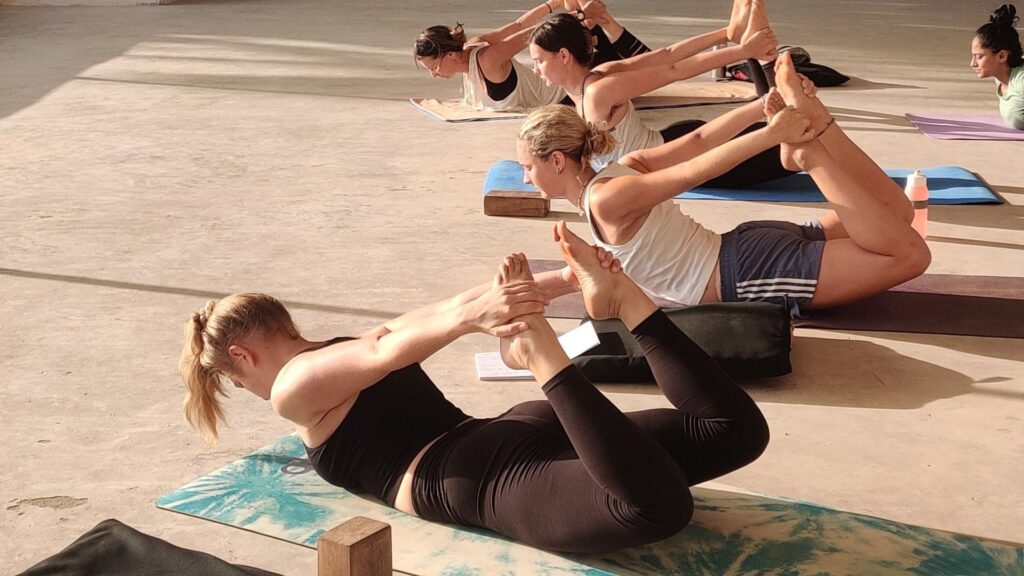The main benefit of Dhanurasana is to improve the spinal’s health. However, as many other yoga postures, Dhanurasana has much more impact on your body. These benefits are :
- Spine flexibility
- Core strengthening
- Chest opening
- Digestive health
- Back pain relief
- Stress reduction
- Improved circulation
- Thigh and hip flexor stretch
- Shoulder and chest strengthening
- Stimulates endocrine glands
In the following line, we aim to develop in what way the Bow Pose affects positively your body and your health.
How Dhanurasana helps spine flexibility ?
Bow pose can help spine flexibility in three ways, which we expose to you.
Dhanurasana increases intervertebral disc space
Dhanurasana (Bow Pose) creates traction on the columna vertebralis (spine), which can help increase the intervertebral disc space, including the anulus fibrosus and nucleus pulposus. This traction-induced decompression reduces the intradiscal pressure, alleviating stress on the intervertebral discs (disci intervertebrales) and nerve roots (radices nervorum).
By decompressing the spine, Dhanurasana helps to relieve compression on the spinal nerves, including the nervus ischiadicus (sciatic nerve), thereby potentially alleviating conditions such as sciatica (ischiadica). This decompression facilitates increased hydration and nutrient exchange within the intervertebral discs, promoting disc health and resilience.

Furthermore, the reduction in pressure helps in realigning the vertebrae (vertebrae) and can correct minor postural deviations. This contributes to enhanced spinal flexibility (flexibilitas spinalis) and a greater range of motion (amplitudo motus).
The overall effect of Dhanurasana’s traction on the spine is not only therapeutic for those suffering from lower back pain (dolor lumbalis) and sciatica but also preventive, as it promotes spinal health and flexibility, reducing the likelihood of future spinal ailments.
Dhanurasana elongates the anterior spinal lengthening
Dhanurasana (Bow Pose) elongates the ligamentum longitudinale anterius (anterior longitudinal ligament), which runs along the anterior aspect of the vertebral bodies (corpora vertebrarum). This lengthening of the ligamentum longitudinale anterius is crucial as it contributes to increased spinal flexibility (flexibilitas spinalis) and suppleness.
The anterior longitudinal ligament is responsible for limiting hyperextension of the vertebral column and maintaining spinal stability. By stretching this ligament, Dhanurasana promotes greater elasticity (elasticitas) and flexibility within the spinal structure. This improved elasticity allows for a wider range of motion (amplitudo motus) and enhances the spine’s ability to absorb and distribute mechanical stress.

Additionally, the lengthening of the anterior longitudinal ligament through Dhanurasana helps in maintaining proper vertebral alignment (allineatio vertebralis) and posture (postura). This contributes to overall spinal health and reduces the risk of developing conditions associated with spinal rigidity (rigiditas spinalis) and misalignment.
Dhanurasana enhances paraspinal muscle strength
Dhanurasana (Bow Pose) engages the musculi erector spinae, a group of muscles that run vertically along the spine and play a crucial role in maintaining posture and spinal stability. These muscles include longissimus capitis, spinalis cervicis, iliocostalis cervicis, longissimus cervicis, spinalis thoracis, longissimus thoracis, and iliocostalis lumborum.
The longissimus capitis, spinalis cervicis, and iliocostalis cervicis are primarily involved in supporting and stabilizing the cervical spine, improving neck posture and flexibility. By engaging these muscles, Dhanurasana enhances the strength and stability of the neck region, reducing the risk of neck strain and promoting better head posture.
The longissimus cervicis and spinalis thoracis focus on the thoracic spine, supporting an upright posture and preventing conditions such as kyphosis. Strengthening these muscles through Dhanurasana contributes to better alignment and stability in the middle back.

The longissimus thoracis and iliocostalis lumborum muscles support the lumbar spine, improving lower back strength and flexibility. By engaging these muscles, Dhanurasana helps to stabilize the lower back, reducing the risk of lower back pain and enhancing overall spinal flexibility.
By strengthening the entire erector spinae muscle group, Dhanurasana provides comprehensive support to the vertebral column (columna vertebralis). This increased muscular strength contributes to improved posture (postura) and spinal flexibility (flexibilitas spinalis). Additionally, a strong erector spinae muscle group enhances the spine’s ability to absorb and distribute mechanical stress, promoting overall spinal health and reducing the risk of back pain (dolor dorsi) and other spinal conditions.
Dhanurasana reduces muscular stiffness
Dhanurasana (Bow Pose) strengthens and stretches the musculi dorsi (back muscles), which significantly reduces muscular stiffness (rigiditas muscularis) and enhances the elasticity (elasticitas) of the muscle fibers (fibrae musculares). This increased elasticity is crucial as it allows for a greater range of motion (amplitudo motus) and improved spinal flexibility (flexibilitas spinalis).
The reduction in muscular stiffness helps to alleviate tension within the back muscles, promoting relaxation and reducing the risk of muscle spasms (spasmi musculares). Enhanced elasticity of the muscle fibers contributes to more fluid and efficient movements, supporting better overall spinal function.
By improving the flexibility of the back muscles, Dhanurasana facilitates smoother and more extensive movements of the spine, thereby enhancing the spine’s ability to perform complex motions. This increased range of motion is essential for maintaining spinal health and preventing injuries related to restricted movement or muscle tightness.
Furthermore, the combination of strengthening and stretching in Dhanurasana supports the structural integrity of the back muscles, contributing to better posture (postura) and alignment (allineatio). This holistic improvement in muscle function and flexibility promotes a healthier, more resilient spine, capable of withstanding daily physical demands and reducing the likelihood of developing chronic back issues.
Dhanurasana improved facet joint mobility
Dhanurasana (Bow Pose) involves a deep backbend movement that mobilizes the articulationes zygapophysiales (facet joints), which connect the vertebrae (vertebrae) in the spine. These facet joints are synovial joints, allowing for smooth and controlled movements between the vertebrae.

Enhanced mobility of the facet joints through Dhanurasana contributes to a greater range of motion (amplitudo motus) and increased spinal flexibility (flexibilitas spinalis). By mobilizing these joints, Dhanurasana helps to maintain their functional health, ensuring that the spine can move freely and efficiently.
The improved mobility of the facet joints reduces stiffness (rigiditas) and promotes fluid motion, which is essential for performing daily activities that require spinal flexion, extension, and rotation. This increased joint flexibility helps to distribute mechanical stress more evenly across the spine, reducing the risk of joint degeneration and associated spinal conditions.
Dhanurasana release tension in ligaments
Dhanurasana (Bow Pose) helps release tension in the spinal ligaments, specifically the ligamentum flavum (also called the yellow ligament) and the ligamentum supraspinale (supraspinous ligament). The ligamentum flavum is a thick, segmental ligament that runs between the laminae of adjacent vertebrae, while the ligamentum supraspinale joins the posterior tips of adjacent spinous processes, extending as far as L3-L4.

Releasing tension in the ligamentum flavum and ligamentum supraspinale through Dhanurasana facilitates more fluid movements (motus fluidi) and significantly enhances spinal flexibility (flexibilitas spinalis). The ligamentum flavum, due to its elasticity, plays a crucial role in maintaining the integrity and alignment of the vertebral column (columna vertebralis) during flexion and extension movements. By stretching this ligament, Dhanurasana reduces rigidity (rigiditas) and promotes smoother, more efficient spinal motion.
The ligamentum supraspinale, which provides support to the spinous processes, also benefits from the release of tension, contributing to better posture (postura) and spinal alignment (allineatio vertebralis). Reducing tension in these ligaments helps to alleviate discomfort and stiffness, allowing for a greater range of motion (amplitudo motus) in the spine.
Dhanurasana corrects spinal curvature
Dhanurasana (Bow Pose) helps in correcting exaggerated spinal curvatures such as kyphosis (hyperkyphosis thoracica), which is an excessive curvature of the thoracic spine. The pose promotes the extension (extensio) of the thoracic spine (pars thoracica columnae vertebralis), counteracting the forward rounding that characterizes kyphosis.
As detailed in the study “Non-structural misalignments of body posture in the sagittal plane” by Dariusz Czaprowski, Łukasz Stoliński, Marcin Tyrakowski, Mateusz Kozinoga, and Tomasz Kotwicki, proper alignment of spinal curvature (curvatura vertebralis) supports better flexibility (flexibilitas) and overall spinal function (functio spinalis). By extending the thoracic spine, Dhanurasana helps realign the vertebral bodies (corpora vertebrarum), reducing the exaggerated curvature and promoting a more neutral spinal posture (postura vertebralis).
Correcting spinal misalignments through Dhanurasana not only enhances spinal flexibility but also improves the biomechanics of the spine, allowing for more efficient and pain-free movement. Proper alignment reduces abnormal stress on the vertebrae and intervertebral discs (disci intervertebrales), decreasing the likelihood of degenerative changes and associated spinal disorders.
Dhanurasana enhances neural function
Dhanurasana (Bow Pose) involves the stretching and lengthening (tractus et elongatio) of the spine (columna vertebralis), which stimulates the spinal nerves (nervi spinales). This stimulation can potentially improve neural conductivity (conductio nervosa), enhancing the transmission of nerve impulses along the spinal cord (medulla spinalis) and peripheral nerves.
Enhanced neural function (functio nervosa meliorata) resulting from this stimulation can lead to better muscle coordination (coordinatio muscularis) and increased flexibility (flexibilitas). When the spinal nerves function optimally, they more effectively transmit signals between the central nervous system (systema nervosum centrale) and the muscles (musculi), promoting more precise and coordinated muscle movements.
Improved neural conductivity also supports proprioception (proprioceptio), the body’s ability to sense its position and movement in space. This enhanced proprioceptive feedback contributes to better balance and control during physical activities, further promoting spinal and overall musculoskeletal health (sanitas musculoskeletalis).
Dhanurasana increases vascular supply
The bow pose increases blood flow to the spinal region, which nourishes the spinal discs, vertebrae, and surrounding muscles. As mentioned in “Blood Supply and Vascular Reactivity of the Spinal Cord Under Normal and Pathological Conditions” written by Nikolay Martirosyan in May 2016 for the Arizona State University, improved vascular supply promotes the health and flexibility of spinal tissues.
How Dhanurasana helps core strengthening ?
Dhanurasana actives rectus abdominis
Bow Pose requires lifting both the chest (pectus) and legs (crura) off the ground, which intensely engages the musculi rectus abdominis. The rectus abdominis muscles are slung between the ribs (costae) and the pubic bone (os pubis) at the front of the pelvis (pelvis anterior).
This intense engagement strengthens the front core muscles (musculi centrales anteriores), contributing significantly to overall core stability (stabilitas centralis) and strength (vis). Strengthening the rectus abdominis helps in maintaining proper posture (postura) and spinal alignment (allineatio spinalis) by providing robust support to the lumbar region (regio lumbalis).

Moreover, a strong rectus abdominis improves intra-abdominal pressure (pressio intraabdominalis), which is essential for supporting the spine during various physical activities and reducing the risk of lower back pain (dolor lumbalis). Enhanced core strength also facilitates better balance (equilibrio) and coordination (coordinatio) during dynamic movements, contributing to overall functional fitness and physical performance.
Dhanurasana engages transverse abdominis
Holding the pose engages the transverse abdominis, the deepest of the 6 abdominal muscles.Transverse abdominis extends between the ribs and the pelvis, wrapping around the trunk from front to back. It acts like a corset around the spine. Strengthening this muscle enhances core stability and supports better spinal alignment.

Dhanurasana actives oblique muscle
Dhanurasana (Bow Pose) also activates the musculi obliquus internus abdominis (internal oblique muscles) and musculi obliquus externus abdominis (external oblique muscles). These muscles run down either side of the abdomen (abdomen lateralis), playing a crucial role in providing lateral stability (stabilitas lateralis) and core strength (vis centralis).
Activation of the internal and external oblique muscles enhances overall body balance (equilibrium corporis) and coordination (coordinatio corporis). These muscles are essential for trunk rotation (rotatio trunci) and side bending (inclinatio lateralis), contributing to dynamic stability during various movements.

Strengthening the oblique muscles through Dhanurasana supports the integrity of the abdominal wall (paries abdominalis) and improves the ability to stabilize the pelvis (stabilitas pelvis) and spine (columna vertebralis) during physical activities. This enhanced stability is vital for maintaining proper posture (postura) and preventing injuries related to muscle imbalances and weak core musculature.
How Dhanurasana helps chest opening ?
Dhanurasana stretches the pectoral muscle
Dhanurasana (Bow Pose) stretches the musculus pectoralis major and musculus pectoralis minor, which are located in the chest (thorax). This stretch helps in expanding the thoracic cavity (cavitas thoracica), improving chest flexibility (flexibilitas pectoralis) and reducing tightness (rigiditas) in the chest muscles.
Expanding the thoracic cavity through this stretch increases the range of motion (amplitudo motus) of the rib cage (costa), allowing for deeper and more efficient breathing (respiratio). Improved flexibility of the pectoralis major and minor muscles also enhances posture (postura), as these muscles play a key role in maintaining the alignment of the shoulders (scapulae) and upper spine (pars superior columnae vertebralis).
Reducing tightness in the chest muscles helps alleviate discomfort and prevent musculoskeletal imbalances (desequilibria musculoskeletalis) that can arise from poor posture or repetitive strain. This not only contributes to better overall physical function but also enhances respiratory efficiency by allowing the lungs (pulmones) to expand more fully during inhalation.
Dhanurasana expanses rib cage
The deep arching of the back in Dhanurasana promotes the expansion of the rib cage. This expansion increases lung capacity – which is about 6 liters for healthy adults as mentioned in “Physiology, Lung Capacity” written by Benjamin J. Delgado; Tushar Bajaj – and enhances respiratory efficiency, contributing to better oxygenation of the body.
Dhanurasana improves shoulder flexibility
Bow pose stretches and opens the shoulders, particularly the deltoids and the 4 rotator cuff muscles called Supraspinatus, Infraspinatus, Teres minor, Subscapularis which assist the deltoids with moving the arm in different directions and help keep the shoulder centered . Improved shoulder flexibility contributes to a more open and expansive chest, aiding in better posture and breathing.

How Dhanurasana helps digestive health ?
Dhanurasana compresses abdominal region
The deep bend in Dhanurasana (Bow Pose) compresses the abdominal region (regio abdominalis), stimulating the digestive organs such as the stomach (ventriculus), intestines (intestina), and liver (hepar). This compression can help in improving peristalsis (peristalsis), the wave-like contractions that move food through the digestive tract (tractus digestivus).
By applying gentle pressure to the abdominal organs, Dhanurasana enhances their function and promotes better digestion (digestio). The compression of the stomach and intestines aids in facilitating the movement of food and waste, thereby improving gastrointestinal motility (motilitas gastrointestinalis).
Stimulating the liver through this pose can enhance its metabolic and detoxification processes (processus metabolici et detoxificationis), ensuring more efficient processing of nutrients and elimination of toxins. Additionally, improved peristalsis can help prevent digestive issues such as constipation (constipatio) and bloating (meteorismus).
Dhanurasana improves blood circulation in digestive organs
Dhanurasana (Bow Pose) enhances blood circulation to the abdominal organs, including the ventriculus (stomach), intestinum (intestines), hepar (liver), and pancreas. This improved vascular supply, or perfusion, ensures that these organs receive an increased amount of oxygen (O2) and essential nutrients, which are critical for their optimal physiological functions.
Enhanced blood flow to the intestinum tenue (small intestine) and intestinum crassum (large intestine) facilitates better nutrient absorption (assimilatio nutrimentorum). This process ensures that vitamins, minerals, and other vital nutrients are efficiently absorbed into the bloodstream, supporting overall metabolic health.
In the hepar, increased circulation supports its numerous functions, including glycogen storage, decomposition of red blood cells, plasma protein synthesis, and detoxification (detoxificatio). Efficient blood flow helps the liver process and eliminate toxins more effectively, thereby improving hepatic function.
Enhanced perfusion also benefits the pancreas by promoting optimal insulin production and secretion, which is needed for maintaining glucose homeostasis. Moreover, improved blood circulation aids in the removal of metabolic waste products (excretiones metabolicae) from these digestive organs, preventing the accumulation of harmful substances that could impair their function.
Stimulation of the parasympathetic nervous system
Dhanurasana stimulates the parasympathetic nervous system, which is responsible for the “rest and digest” functions. This stimulation helps in promoting relaxation and efficient digestion.

How Dhanurasana helps stress reduction ?
Dhanurasana reduces cortisol levels
Practicing Dhanurasana (Bow Pose) can help activate the parasympathetic nervous system (systema nervosum parasympathicum), which counteracts the stress response (responsio ad stressum) and reduces cortisol levels (gradus cortisoli). Lower cortisol levels (gradus inferior cortisoli) are associated with decreased stress (stressus minor) and anxiety (anxietas).
Activation of the parasympathetic nervous system induces a relaxation response (responsio relaxationis), promoting physiological states that support calmness and recovery (restitutio). This shift from the sympathetic “fight or flight” response to the parasympathetic “rest and digest” state helps in lowering heart rate (frequentia cardiaca) and blood pressure (pressio sanguinis), thereby reducing overall physiological stress.
Decreased cortisol levels have significant benefits for mental health (sanitas mentalis), including reduced feelings of anxiety and improved mood (animi status melioratus). Lowering cortisol also supports better immune function (functio immunis) and reduces the risk of stress-related health issues (problematica valetudinis stressu correlata), such as hypertension (hypertensio) and metabolic disorders (morbi metabolici).
Dhanurasana enhanced relaxation response
Dhanurasana (Bow Pose) encourages deep breathing (respiratio profunda) and relaxation (relaxatio) of the mind (mens) and body (corpus), promoting a state of calm (status tranquillitatis) and reducing the physical symptoms of stress (symptoma physica stressus) such as muscle tension (tensio muscularis) and high blood pressure (hypertensio).
Deep breathing facilitated by this asana enhances oxygenation (oxygenatio) of the blood and improves respiratory efficiency (efficientia respiratoria), which helps in calming the nervous system (systema nervosum). This deep, diaphragmatic breathing activates the parasympathetic nervous system (systema nervosum parasympathicum), which counteracts the stress response (responsio ad stressum) and induces a relaxation response (responsio relaxationis).
The relaxation of the body achieved through Dhanurasana helps to alleviate muscle tension (tensio muscularis), which is a common physical manifestation of stress. By reducing muscular tightness, the asana enhances overall physical comfort and reduces the risk of stress-related musculoskeletal issues (problematica musculoskeletalis stressu correlata).
Additionally, by lowering high blood pressure (hypertensio), Dhanurasana supports cardiovascular health (sanitas cardiovascularis) and reduces the risk of stress-induced hypertension (hypertensio stressu inducta). The combined effect of deep breathing and physical relaxation promotes a holistic state of calm and well-being (status generalis tranquillitatis et valetudinis).
Dhanurasana improves mood and mental clarity
By stretching the front body and opening the chest, Dhanurasana helps release stored tension, leading to improved mood and mental clarity. This can contribute to a reduction in overall stress levels.
How Dhanurasana helps improve blood circulation ?
Dhanusarana increases blood flow to the spinal region
The arching motion of Dhanurasana enhances blood flow to the spine and surrounding muscles, improving the supply of oxygen and nutrients to these areas and promoting overall spinal health.
Dhanurasana improves venous return
The pose aids in improving venous return, the flow of blood back to the heart. Enhanced venous return ensures efficient circulation and reduces the risk of blood pooling in the lower extremities.
Stimulation of the Heart
By expanding the chest and increasing lung capacity, Dhanurasana can stimulate the heart to pump more efficiently, thereby improving overall cardiovascular health and circulation.
How Dhanurasana helps thigh and hip flexor stretch ?
Dhanurasana stretches Iliopsoas
Dhanurasana (Bow Pose) facilitates the elongation of the musculus iliopsoas, a principal hip flexor. This stretch effectively reduces muscular tightness (rigiditas musculorum) and enhances flexibility (flexibilitas) within the hip region (regio coxae), which is critical for biomechanical efficiency in activities such as ambulation (ambulatio) and running (cursus).
The iliopsoas complex, comprising the psoas major and iliacus muscles, is integral to hip flexion (flexio coxae) and lumbar spine stabilization (stabilitas columnae lumbalis). By inducing an elongated state in these muscles, Dhanurasana mitigates myofascial tension and augments the range of motion (amplitudo motus) at the hip joint (articulatio coxae).
Enhanced pliability of the iliopsoas contributes to optimized kinematic function during lower limb activities, thereby improving performance in locomotor tasks requiring cyclical hip flexion and extension. Additionally, the alleviation of iliopsoas tightness reduces the biomechanical load on the lumbar spine, potentially decreasing lumbar discomfort (dolor lumbalis) and promoting proper postural alignment (allineatio posturalis).
Augmented hip flexibility (flexibilitas coxae) is paramount for maintaining comprehensive functional mobility and supporting the kinetic chain’s overall efficiency (efficientia catenae kineticae). Through consistent practice of Dhanurasana, individuals can enhance the viscoelastic properties and functional capacity of the iliopsoas muscle, facilitating more efficient and fluid movement patterns in both everyday and athletic activities.
Dhanurasana stretches quadriceps
(Bow Pose) also induces elongation of the quadriceps femoris muscle group, located on the anterior aspect of the thighs (musculi quadriceps femoris). Enhanced flexibility (flexibilitas) in the quadriceps muscles (musculi quadriceps) can alleviate strain on the knee joints (articulationes genus) and enhance overall leg function (functio cruris).
The quadriceps femoris, consisting of the rectus femoris, vastus lateralis, vastus medialis, and vastus intermedius, plays a pivotal role in knee extension (extensio genus) and stabilization (stabilitas). By stretching these muscles, Dhanurasana reduces myofascial tightness and increases the range of motion (amplitudo motus) at the knee joint.
Improved quadriceps flexibility decreases the tensile forces exerted on the patella (patella) and associated ligamentous structures (ligamenta), thereby mitigating the risk of patellofemoral pain syndrome and other knee-related pathologies. Furthermore, enhanced muscle pliability contributes to the optimization of the lower limb kinetic chain (catena kinetica inferior), promoting more efficient and biomechanically sound movements.
Regular practice of Dhanurasana can lead to sustained improvements in quadriceps flexibility, supporting the functional integrity of the knee joints and augmenting overall leg performance. This biomechanical enhancement is crucial for maintaining lower extremity health and preventing overuse injuries (injuriae ex usu), thereby promoting long-term musculoskeletal well-being (valetudo musculoskeletalis).
Dhanurasana enhances hip flexor mobility
By extending the hips and engaging the hip flexors, Dhanurasana (Bow Pose) enhances mobility and flexibility in the hip joints (articulationes coxae). This increased hip flexibility can alleviate lower back pain (dolor lumbalis) and improve posture (postura).
Engaging the hip flexors (musculi flexores coxae) in this pose helps reduce muscular tightness (rigiditas musculorum) and improves the range of motion (amplitudo motus). Enhanced hip joint mobility supports better alignment (allineatio) and reduces stress on the lumbar spine (columna lumbalis).
Regular practice of Dhanurasana can lead to improved postural alignment and reduced lower back discomfort. This contributes to overall spinal health (sanitas spinalis) and functional movement efficiency (efficientia motus functionalis).
How Dhanurasana helps stimulate endocrine glands ?
Dhanurasana stimulates thyroid and parathyroid
The compression and extension of the neck in Dhanurasana (Bow Pose) can stimulate the thyroid (glandula thyroidea) and parathyroid glands (glandulae parathyroideae). These glands are crucial for metabolic regulation (regulatio metabolica) and calcium homeostasis (homeostasis calcii), respectively.
Stimulating the thyroid gland enhances its secretion of hormones that regulate metabolism (metabolismus), affecting energy levels and overall metabolic function. Activation of the parathyroid glands promotes calcium regulation, crucial for bone health (sanitas ossium) and neuromuscular function (functio neuromuscularis).
Regular practice of Dhanurasana can support the endocrine function (functio endocrina) of these glands, contributing to balanced metabolic and calcium levels in the body.
Dhanurasana stimulate adrenal glands
Dhanurasana (Bow Pose) can stimulate the adrenal glands (glandulae suprarenales), located above the kidneys (renes). This activation helps regulate the body’s stress response (responsio ad stressum) and maintain energy levels (gradus energiae).
Stimulation of the adrenal glands enhances the secretion of hormones like cortisol and adrenaline. These hormones are crucial for managing stress (stressus) and sustaining energy (energia).
Regular practice of Dhanurasana supports adrenal function (functio suprarenalis), promoting balanced stress regulation and consistent energy levels in the body.
Dhanurasana stimulates the pancreas
The deep abdominal compression in Dhanurasana (Bow Pose) can stimulate the pancreas (pancreas). This stimulation promotes better insulin production (productio insulinae) and regulation (regulatio insulinae), which are vital for maintaining healthy blood sugar levels (gradus glucosi sanguinis).
Compression of the abdominal region enhances blood flow (perfusion) to the pancreas, optimizing its endocrine function. Improved insulin secretion facilitates glucose uptake (absorptio glucosi) by cells, aiding in energy production (productio energiae) and metabolic balance (aequilibrium metabolicum).
Regular practice of Dhanurasana can support pancreatic health (sanitas pancreatica), reducing the risk of insulin resistance (resistentia insulinae) and associated metabolic disorders (morbi metabolici). This contributes to overall glycemic control (controllum glycemicum) and long-term metabolic health (sanitas metabolicus).
The practice of Dhanurasana helps you in an overall perspective
As you may have read, occasional or regular practice of Bow Pose can first improve your physical conditions. From a muscular and articular perspective, it even affects your deep metabolism. Taken seriously, this exercise also helps to improve your mental health and breathing. In other words, you should not miss out on practicing Dhanurasana, whether you are a beginner in yoga or an experienced practitioner.

